Ireland has many green hills, lots of sheep and a great west coast with steep cliffs. Those are well-known facts.
Page Contents (click line to jump the text)

Intro
But did you know that Ireland also has a lot of history? Are you a little bit interested in history?
Me too. When I travel, I like to read a bit beforehand and get at least a small overview and choose a few historical towns to visit on the trip.
Depending on the itinerary, I don’t visit all of them, but at least a few. I think that makes the trip even more interesting.
You feel the same way? Great! Then I have a little summary for you here, which beautiful places in Ireland’s east and sights you can visit on your trip.
You will get very interesting insights into Ireland’s history, from early times, through the Middle Ages to the 19th century.
I have included the places in an exemplary 8-day round trip. Then you already have a first draft for your travel planning!
I myself have mostly visited the sights individually, or in combination with other round trips. My family and I are from Germany, but have been living in Ireland’s east, south of Dublin (second home) for several years now.
So, let me tell you about the highlights you can see here in Ireland’s Ancient East:
Ireland`s Ancient East
Ireland’s Ancient East is actually called “Ireland’s Ancient East”. It is a marketing term used in Irish tourism. Regionally, the Ancient East covers the east coast of Ireland including Dublin and the south coast to Cork. The western border of the Ancient East is formed by the Midlands or Heartlands with the Shannon as a natural barrier.
But “Ireland`s Ancient East” is indeed a very well-chosen term, because it is precisely in the east, in a wide belt around Dublin, that many exciting historical events took place, the stone witnesses of which we can still admire today.
The Irish island was conquered many times in the course of its history: the Celts were by no means the original inhabitants of Ireland, they were the first warlike conquerors. They were followed by the Vikings, the Anglo-Normans and finally the English.
The Celtic faith was followed by Christianisation and, with the monasteries, by Christian doctrine. In the Middle Ages, Irish monasteries were regarded as universities for noble sons from all over Europe.
The fertile soils of the east coast and the Midlands offered good pasture and arable land and were therefore of greater value to the conquerors than the stony barren west coast.
The east coast has always been richer than the west, the castles larger, the monasteries more significant and so it is not surprising that each new era of conquerors has always targeted the east first.
We start our virtual historical tour north of Dublin and then travel south and loop back to Dublin:

Day 1: Monasterboice, Newgrange, Hill of Tara, Trim Castle
The first day takes you to the Boyne Valley, north of Dublin.
We start at Monasterboice, a former monastic site from the early Middle Ages. You will find a well-preserved round tower, which was very typical of Irish monasteries of its time, but of which there are not many left in good condition. You will also find two high crosses and several other fine Celtic crosses here at Monasterboice.
Southwest of Drogheda you will find the Brú na Bóinne Visitor Centre. There you can get admission to Newgrange and Knowth, which you can only see on a guided tour. You should book this in advance, as tours are limited and can be fully booked, especially in the summer months.
Newgrange is a fantastically preserved, large so-called Passage Tomb, i.e. a mound heaped up of large stones and earth, with passages and inner rooms. The continuous central passage is aligned with the sunrise at the winter solstice.
Unscientifically, one could speak of a kind of Celtic pyramid, although the site was probably not a burial place but rather a temple. There are other passage tombs in the immediate vicinity, namely Knowth and Dowth. These sites probably date from around 3200 BC, so they are just over 5000 years old.
A little further on you will find the Hill of Tara. There is also a 5000-year-old passage tomb, the Mound of the Hostages. The Hill of Tara is famous because the regional kings of the province of Leinster were crowned here around 400-600 BC. Some of them also called themselves High Kings of Ireland, but this is not entirely undisputed.
The wooden fortifications and houses are no longer visible, but remains of the associated ramparts and tombs, as well as the Lia Fáil, the Stone of Destiny or Coronation, are. The Hill of Tara Visitor Centre informs you about the time, the visit is free.
Continue on to Trim, where Trim Castle awaits you. The imposing castle has been badly damaged, but its dimensions are still impressive. In fact, it was the largest Anglo-Norman castle on the island. You can visit Trim Castle from the inside, but even a walk around the extensive castle on the River Boyne is an experience.
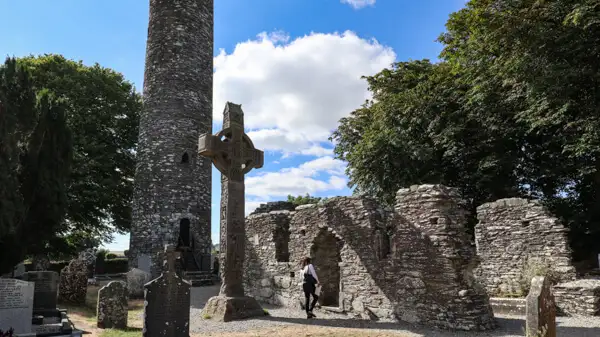
Day 2: Wicklow – Garden of Ireland: Powerscourt Estate, Powerscourt Waterfall and Glendalough Monastic City
South of Dublin lie the Wicklow Mountains. County Wicklow is also called the Garden of Ireland because there are particularly many beautiful mansions with ornate gardens here.
Most of them date from the 18th century and were built by wealthy English noblemen.
Powerscourt Castle was built in the 14th century and later, in the 18th century, was converted into the magnificent Powerscourt House and Gardens or Mansion and Park. The over 10 hectares of parkland were also artistically laid out in the French style of the time and include a rose garden, Japanese garden, lakes, ponds, streams and beautiful mature trees.
A few kilometres further on you will find Powerscourt Waterfall. It used to be on the estate, which gives you an idea of the size of the estate! The waterfall is 120 metres high, making it the highest waterfall in Ireland.
A scenic drive through the Wicklow Mountains via Lough Tay and Sally Gap takes you to the Glenadalough Monastic Site. At the Visitor Centre you will find the car park and the entrance to the Glen-da-Lough.
Just a few metres from the Visitor Centre you will see a beautifully preserved round tower, an old stone chapel and some well preserved outbuildings. The church itself is only partially preserved. Around it you will find numerous Celtic crosses, some of them very beautiful.
The early medieval monastery complex was one of the most important of its time. This is where the wealthy nobles of the continent once sent their sons to study.
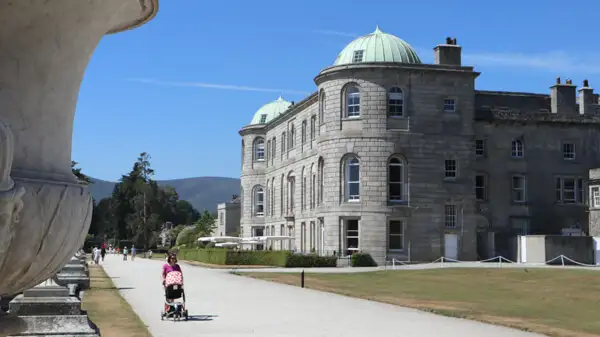
Day 3: Enniscorthy Rebellion Centre, Vinegar Hill and Castle
Enniscorthy is a pleasant old town on a hill overlooking the River Slaney. The bridge and river are guarded by Enniscorthy Castle, a small castle dating from the late 12th and 13th centuries. The castle contains a museum and can be visited.
During the Irish Rebellion against the English in 1798, Enniscorthy Castle was used as a prison. The decisive battle took place on Vinegar Hill within sight of the castle, which you can explore on a walk. The National 1798 Rebellion Centre provides information about this turbulent time.
The rest of the day is free to relax: Ireland’s south-east coast has over 70 kilometres of fine sandy beaches where you can spend the afternoon. My insider tips are for example: Curracloe Beach, Ballinesker Beach, Morriscastle Beach or The Raven Nature Reserve.
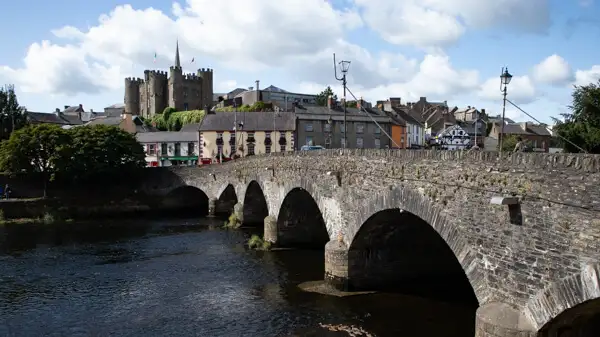
Day 4: Wexford, Irish National Heritage Park, Johnstown Castle
The Vikings not only plundered the monasteries and towns on the Irish coasts, they also settled in Ireland and founded ports, trading posts, settlements and later towns. Good examples of Viking foundations are: Dublin, Wicklow (port), Wexford, Waterford or Limerick.
Wexford is a nice little town at the mouth of the River Slaney into the Irish Sea. The natural harbour, which once helped the Vikings land their boats, is now a fishing and pleasure boat harbour. The pleasant pedestrian zone above the harbour is well worth a stroll.
On the River Slaney you will also find the Irish National Heritage Park. The very natural park is an open-air museum and offers wonderful walks with insights into the life of people in Ireland from the Stone Age to the Vikings and the Middle Ages.
To the south of Wexford is the very beautiful Johnstown Castle. Dating from the 12th century, the castle was extensively rebuilt in the 19th century and given a prestigious appearance. You can visit the castle, the gardens with the beautiful lake, and then there is the Irish Agricultural Museum with beautiful exhibits of former rural life in Ireland.
Day 5: New Ross Dunbrody and the Viking Triangle Waterford
From Wexford it is only a stone’s throw to New Ross. The small town is divided by the River Barrow. On its banks lies an old sailing ship, the Dunbrody. The three-master is a replica of the original Dunbrody from the 19th century.
She was used by thousands of Irish emigrants in the mid-19th century to sail from Ireland to North America and Canada to escape The Great Famine. The small museum informs about the Irish emigrants and the very nice guided tour on the sailing ship is definitely recommended!
The city of Waterford was also founded by the Vikings and is proud of it: the so-called Viking Triangle starts at the harbour, of course – makes sense, doesn’t it?
There you will find Reginald`s Tower with a beautiful replica of a Viking ship. A few metres further on is the King of the Vikings exhibition. Close by is the Waterford Treasures Medieval Museum.
If that’s not enough, you can also visit the House of Waterford Crystal and admire the manufacture of fine crystal products live.
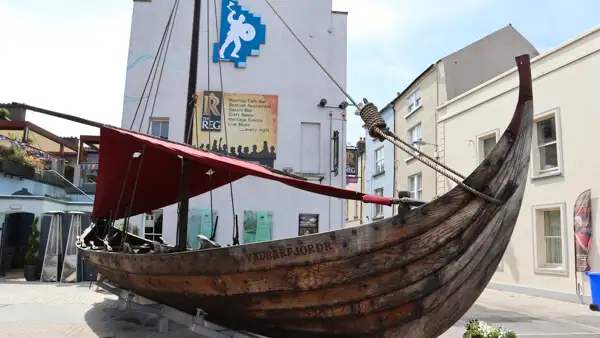
Day 6: Cahir Castle and the Rock of Cashel
Let’s move on to one of my personal favourite castles: Cahir Castle is located in the small town of Cahir, surrounded on all sides by the River Suir. It was built in the 13th century in Norman style, is much smaller than the also Norman Trim Castle, but much better preserved! The visit is definitely worthwhile and the short walk through the park and around the castle is also very beautiful.
The Rock of Cashel is one of Ireland’s most important historical landmarks. The rock, or mountain, rises 65 metres above the otherwise rather flat surrounding countryside. Perched on the mountain is a mighty and, in its constellation, unique mixture of castle fortress and cathedral. At its feet lies the small town of Cashel.
Even in Celtic times, the mountain was a magical and spiritual place. Later, in the 4th century, the native Irish clan built their fortifications on the difficult-to-capture rock. In the 10th century, the site was developed into a royal seat and henceforth served the kings of the province of Munster as a royal seat, similar to what was the case at Tara.
Brian Boru, probably Ireland’s most famous king, ruled here and elevated himself to High King of Ireland before dying a short time later in battle against the Vikings.
In the 12th century the castle passed to the church and was converted into a bishop’s see. The Romanesque chapel dates from this time. The Gothic cathedral was built later, in the 14th century.
Today, the Rock of Cashel is a very beautiful sight that you should definitely visit on your tour.
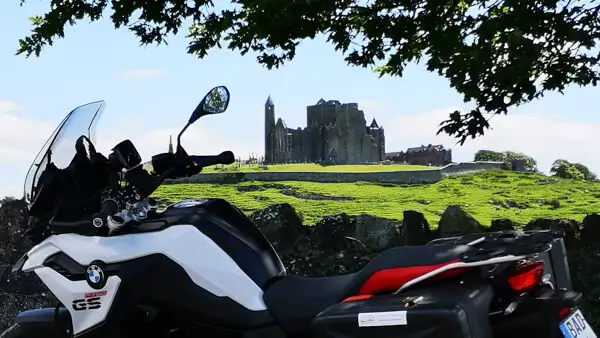
Day 7: Jerpoint Abbey, Kilkenny Castle and Kilkenny Town
On the way to Kilkenny you can make a short stop and visit the beautiful Jerpoint Abbey. It lies in an idyllic rural location south of Thomastown. As inconspicuous as its location may be, the former Cistercian monastery from the 12th century is one of the most important abbeys in Ireland. Here you will find very beautiful stonemasonry, sculptures and ornate tombstones.
Let’s move on to Kilkenny now: The city has a well-preserved medieval town centre with several buildings worth seeing, such as the Town Hall, the Rothe House or the Shee`s Almhouse.
The neo-Gothic St.Marys Cathedral is one of the citys landmarks. The early Gothic St.Canice`s Cathedral is the second largest medieval cathedral in Ireland.
Probably the most famous landmark, however, is Kilkenny Castle, which stands mightily guard over the River Nore. It is only a few minutes’ walk from the old town.
Built in the 14th century as a Norman castle, it was, like many castles of its time, extensively rebuilt in the 19th century, from a less homely fortress to a residential and representative castle with many rooms and halls.
You can walk around the castle for free and enjoy the spacious castle park. But I would also accept the small entrance fee and take the guided tour inside the castle, which takes about an hour and is well worth seeing.
From my personal point of view, Kilkenny is definitely one of the most worth seeing cities in Ireland!
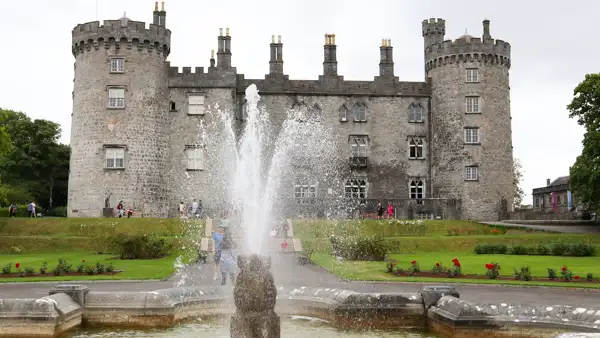
Day 8: Dublin: Christ Church Cathedral, Dublinia, Dublin Castle and Trinity College
A sightseeing tour of Dublin is an essential part of a visit to Ireland. But it doesn’t have to be, because you will most likely arrive via Dublin Airport.
I recommend visiting the city on the last day, so you don’t have to lug your shopping around the whole holiday. I also recommend booking one of the central – and usually expensive – accommodations within walking distance of the Templebar district and exploring Dublin on foot. Driving is fun in the city centre and parking is hard to find.
Must-see attractions certainly include Trinity College with the Book of Kells, Dublin Castle, Christ Church Cathedral and, in my view, Dublinia.
The renowned Trinity College was founded in the 17th century and follows the example of Oxford and Cambridge. The 19-hectare campus is beautifully designed. You can visit it for free and walk among the mighty university buildings in the spirit of Oskar Wilde or Bram Stoker, who studied here.
In the middle of the campus you will find the Old Library where you can admire the oldest book in Ireland, the Book of Kells. Even if the queues to enter are a deterrent, the small exhibition is a lot of fun and the magnificent library with its 64-metre-long Long Room is a must-see and must-be-photographed! The great wood-panelled hall with its round vault and and thousands of books on metre-high shelves is really beautiful to see!
In the middle of the city centre is Dublin Castle to be found. It was built in the early 13th century next to a former Viking settlement. By the way, the Vikings ruled over Dublin and the wider area for about 200 years. Later it became the seat of the English government in Ireland and is today an important building of the Irish government. You can walk through the courtyard or book one of the tours or exhibitions.
Only a few minutes’ walk away and visible from afar is the very imposing Christ Church Cathedral. It is over 1000 years old and architecturally very interesting. A closed passageway above the street connects it with Dublinia, which is housed in the former Synod Hall. The Dublinia houses a very interesting and entertaining partly interactive exhibition on the Vikings and medieval Dublin and gives some impressions of the sites and archaeology. Definitely recommended!
Dublin offers a wealth of interesting buildings, museums, exhibitions, literature, theatre, art and music for culture lovers of all interests. Perhaps you would like to come back for a visit of several days in Dublin?

Conclusion
Isn’t it amazing how many great sights you can see in just one week in Ireland? And you don’t even have to travel far to do it!
On our virtual tour, we (theoretically) saw many interesting and beautiful sights within 8 days and were able to gain numerous exciting insights into Irish history from the Stone Age to the 19th century!
Now it’s your turn: Just do it!
If you drive around Dublin, including the capital, you won’t have to drive too much and will have plenty of time to visit all the beautiful places at your leisure.
This is also a great tip for a second or third visit, as Dublin might serve as a city break in its own right and you should definitely see the west coast too!
With this in mind, I wish you a wonderful holiday in Ireland and many beautiful and historic experiences!
More interesting articles for you
THE MOST BEAUTIFUL CASTLES AND PALACES ON THE IRISH ISLAND – 35 TIPS FOR YOUR ROUND TRIP
VIKINGS – A TOUR IN THE FOOTSTEPS OF THE HIT SERIES – AND THE VIKING HERITAGE OF IRELAND
POSH LIVING IN IRELAND – 26 BEAUTIFUL CASTLE HOTELS FOR YOUR TRIP
A ROUND TRIP BY TRAIN AND BUS THROUGH IRELAND – ALL INFORMATION FOR YOUR TRAVEL PLANNING
Photo credits cover photo: Round tower and celtic cross at the medieval monastery of Glendalough, photo by Ulrich Knüppel-Gertberg (www.irland-insider.de, www.ireland-insider.com)